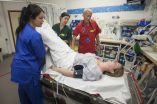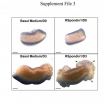Lemon juice and human norovirus
2015-08-25
(Press-News.org) Noroviruses are the predominant cause of gastroenteritis outbreaks in community settings such as hospitals, cruise ships, and schools. The virus is extremely contagious and is mostly transmitted via "fecal-oral-route", i.e., through contaminated hands or contaminated food. Symptoms include violent and sudden onset of diarrhea, vomiting, and nausea.
"It is therefore important to provide a safe and harmless disinfectant against human norovirus," explains Grant Hansman, head of CHS junior research group at the German Cancer Research Center noroviruses and the University of Heidelberg. The group is funded by the CHS Foundation. Some older observations found that fruit extracts, such as orange or pomegranate juice, could reduce the infectivity of surrogate noroviruses.
This current study was a continuation of an earlier project conducted at the National Institutes of Health in the United States, where they discovered that citrate from a commercial company could bind to the norovirus capsid protein. "However, it was only by chance that this discovery was made, like a lot of scientific research, but it turns out to be very interesting." Dr Hansman explains.
Human noroviruses does not grow in cell culture, so they tested the effects of increasing concentrations of citric buffer on the so called norovirus virus-like particles, which have the same surface characteristics as real viruses. Dr Hansman and his staff show that the virus particles change their shape after citrate binding. X-ray crystal structures revealed that the citrate - from lemon juice or citrate disinfectants - precisely interacts at the binding pocket on the particle that is involved in attaching to host ligands - the so-called histo-blood group antigens.
These new results may explain why citrate reduces the infectivity of noroviruses. "Maybe a few drops of lemon juice on contaminated food or surfaces may prevent the transmission of these viruses," speculates Hansman. With his staff, he now plans to investigate if citric acid could reduce symptoms in those already infected with noroviruses.
INFORMATION:
Anna D. Koromyslova, Peter White, and Grant S. Hansman: Citrate alters norovirus particle morphology. Virology 2015, DOI: 10.1016/j.virol.2015.07.009
The German Cancer Research Center (Deutsches Krebsforschungszentrum, DKFZ) with its more than 3,000 employees is the largest biomedical research institute in Germany. At DKFZ, more than 1,000 scientists investigate how cancer develops, identify cancer risk factors and endeavor to find new strategies to prevent people from getting cancer. They develop novel approaches to make tumor diagnosis more precise and treatment of cancer patients more successful. The staff of the Cancer Information Service (KID) offers information about the widespread disease of cancer for patients, their families, and the general public. Jointly with Heidelberg University Hospital, DKFZ has established the National Center for Tumor Diseases (NCT) Heidelberg, where promising approaches from cancer research are translated into the clinic. In the German Consortium for Translational Cancer Research (DKTK), one of six German Centers for Health Research, DKFZ maintains translational centers at seven university partnering sites. Combining excellent university hospitals with high-profile research at a Helmholtz Center is an important contribution to improving the chances of cancer patients. DKFZ is a member of the Helmholtz Association of National Research Centers, with ninety percent of its funding coming from the German Federal Ministry of Education and Research and the remaining ten percent from the State of Baden-Württemberg.
ELSE PRESS RELEASES FROM THIS DATE:
2015-08-25
A simple, safe and cost-free modification to a physical technique used to treat patients in the emergency department with an abnormally fast heart rhythm could improve its effectiveness by more than a quarter, according to a study published in The Lancet today (25 August 2015).
An abnormally fast heart rhythm, also called supraventricular tachycardia, can be distressing for patients and many come to emergency departments for treatment. Symptoms can include chest pain, light-headedness, dizziness and breathlessness. Episodes can last from a few seconds or, in extreme cases, ...
2015-08-25
This news release is available in German. Trillions of bacteria populate the human gut - which makes them more common than any other cells in our body. The composition of this bacterial population is very variable and influenced by our diet. Diseases, but also antibiotic treatments can induce significant shifts in this equilibrium. If entire bacterial groups suddenly multiply heavily, critical situations occur. They damage the intestinal tissue and cause inflammations. How such shifts are triggered largely remained a mystery. Physiologists from the University of Zurich ...
2015-08-25
This news release is available in German.
Root bacteria are known to form symbiotic relationships with plants by improving the plants' supply of nutrients. Yet as scientists at the Max Planck Institute for Chemical Ecology in Jena, Germany, found recently, the bacteria actually play a much more profound role. During field experiments in Utah, in the western USA, researchers discovered that the right mixture of soil microbiota directly influences the survival of Nicotiana attenuata, a species of wild tobacco. Plants that had been unable to establish a protective ...
2015-08-25
University of Manchester scientists have bridged a gap between two separate pieces of small intestine kept alive outside the body, in an advance which could have implications for surgery in human adults and babies.
It is not currently possible to study the intestine in embryos when inside the body, which holds back advances in treatment for conditions causing damage in infants. However, new techniques used by the researchers in this study have allowed organs to be kept alive and grown on supports which allow the absorption of nutrients.
A video is available here
or ...
2015-08-25
In an era where popular culture is increasingly recognized for its impact on lay understanding of health and medicine, few scholars have looked at television's powerful role in the creation of patient expectations, especially regarding pregnancy and birth.
As part of a larger research project funded by a National Science Foundation Dissertation Improvement Grant, Danielle Bessett, University of Cincinnati assistant professor of sociology in the McMicken College of Arts and Sciences examined how women understand their television viewing practices regarding pregnancy and ...
2015-08-25
A team of researchers at the U.S. Department of Energy (DOE)'s Lawrence Berkeley National Laboratory (Berkeley Lab) developing a bioinorganic hybrid approach to artificial photosynthesis have achieved another milestone. Having generated quite a buzz with their hybrid system of semiconducting nanowires and bacteria that used electrons to synthesize carbon dioxide into acetate, the team has now developed a hybrid system that produces renewable molecular hydrogen and uses it to synthesize carbon dioxide into methane, the primary constituent of natural gas.
"This study represents ...
2015-08-25
Waterford, Ireland, August 24, 2015 - Ongoing European Research Council-funded research at Waterford Institute of Technology's (WIT) Macular Pigment Research Group (MPRG) is investigating the potential link between cognitive function and levels of a vital eye pigment linked to diet. The study suggests that measuring macular pigment offers potential as a biomarker of cognitive health. The results of this study are highlighted to a global audience through the prestigious international medical journal, the Journal of Alzheimer's Disease.
The Waterford clinical trial research, ...
2015-08-25
Tahiti is a popular tourist destination, but one unwanted visitor has decided to make its home there: the brown widow spider (Latrodectus geometricus). A paper published in the Journal of Medical Entomology has reported the discovery of the spider for the first time on Tahiti and also on four of the Cook Islands.
The brown widow is a known invasive species. It has been found in South America, Central America, North America, the Caribbean islands, and a host of Pacific islands. It was first found in French Polynesia in 2006, when it was discovered on the island of Moorea. ...
2015-08-25
WASHINGTON (Aug. 25, 2015)--In the most comprehensive study to date, researchers at the George Washington University have identified a potential link between microbes (viruses, bacteria and fungi) in the throat and schizophrenia. This link may offer a way to identify causes and develop treatments of the disease and lead to new diagnostic tests.
"The oropharynx of schizophrenics seems to harbor different proportions of oral bacteria than healthy individuals," said Eduardo Castro-Nallar, a Ph.D. candidate at GW's Computational Biology Institute (CBI) and lead author of ...
2015-08-25
Tampa, Fla. (Aug. 25, 2015) - Fresh water--connecting and sustaining all aspects of life on Earth, including food and energy--is in great danger. Moreover, scientists are worried not only about fresh water; they worry that we are not worried enough about fresh water, especially in light of growing concern over recent events, such as the prolonged California drought. The current Special Issue Section of Technology and Innovation - Journal of the National Academy of Inventors has a special section devoted to fresh water and the challenges it faces from us and from the changing ...
LAST 30 PRESS RELEASES:
[Press-News.org] Lemon juice and human norovirus



